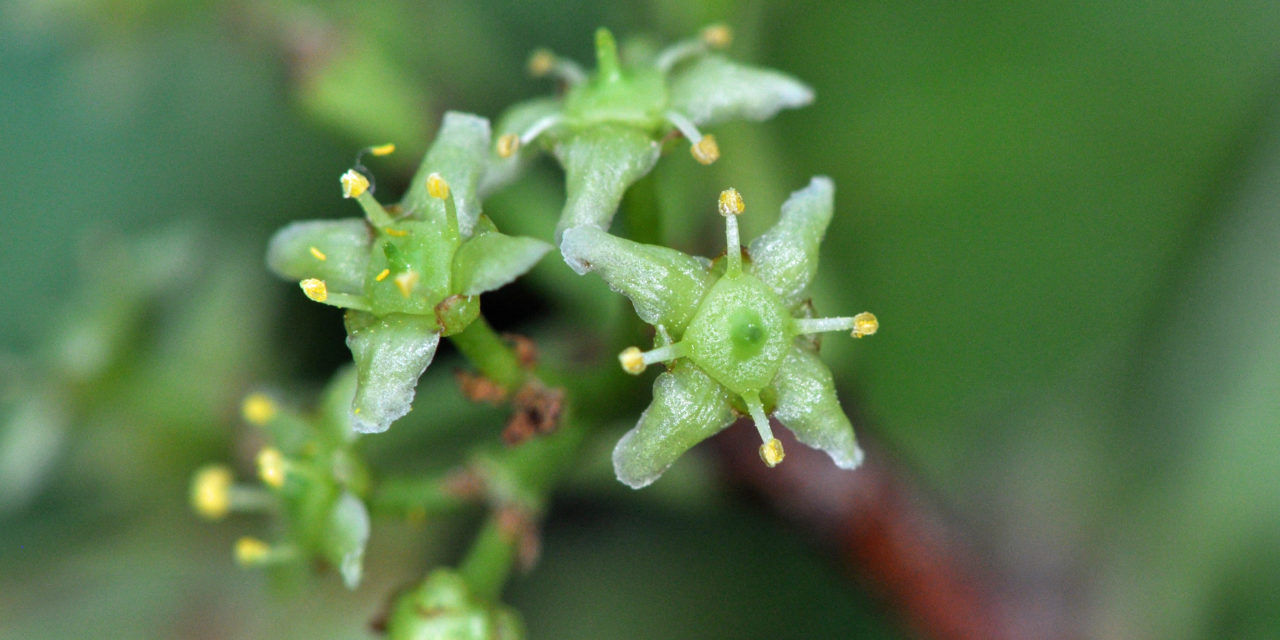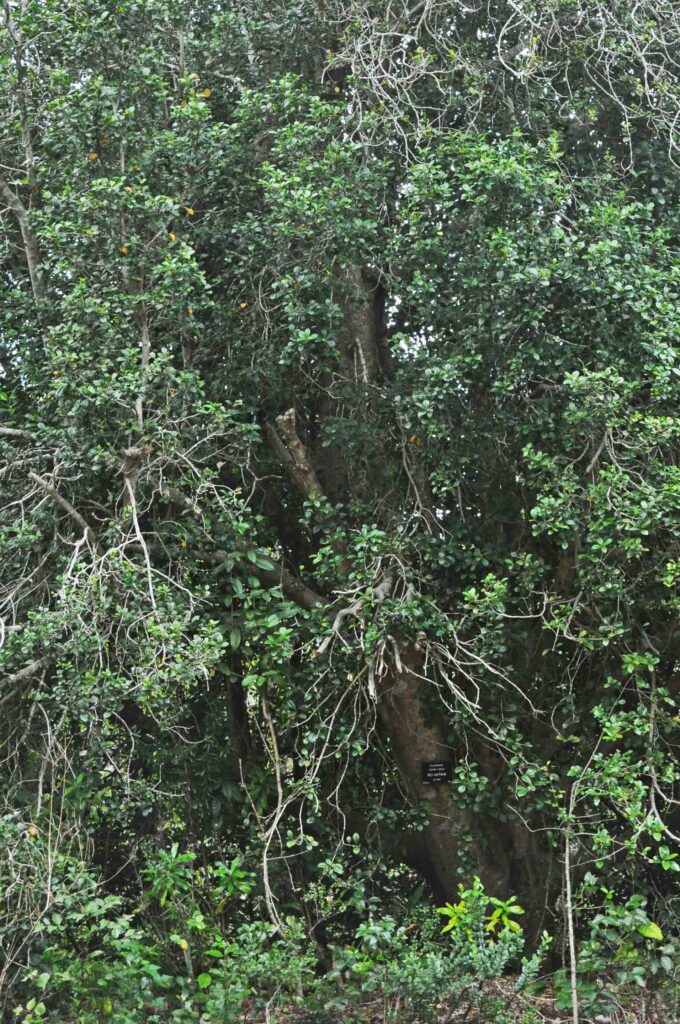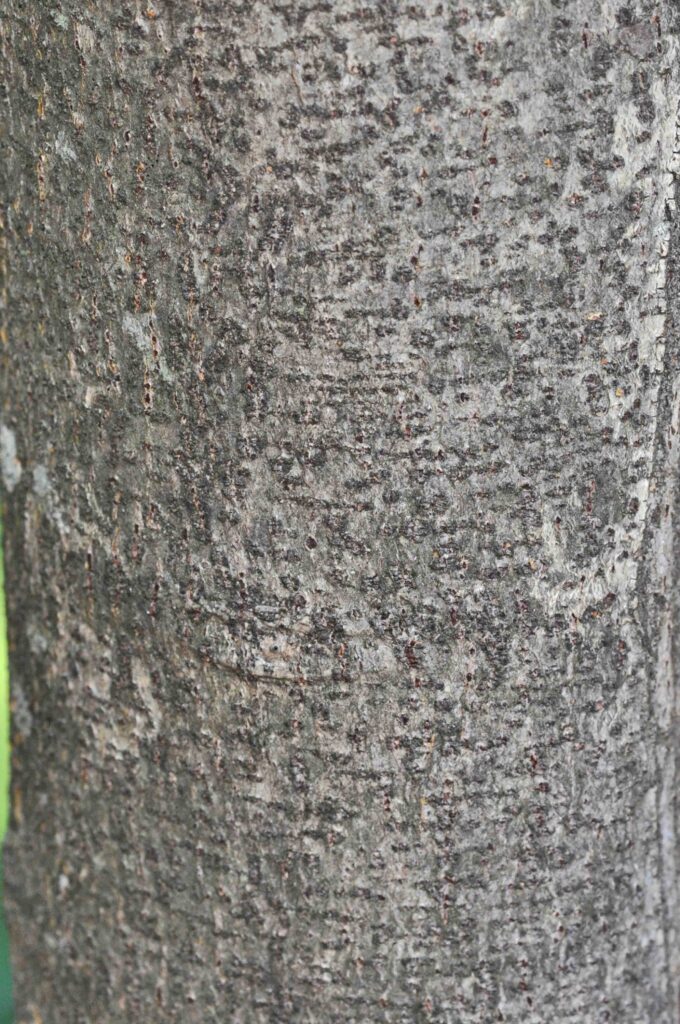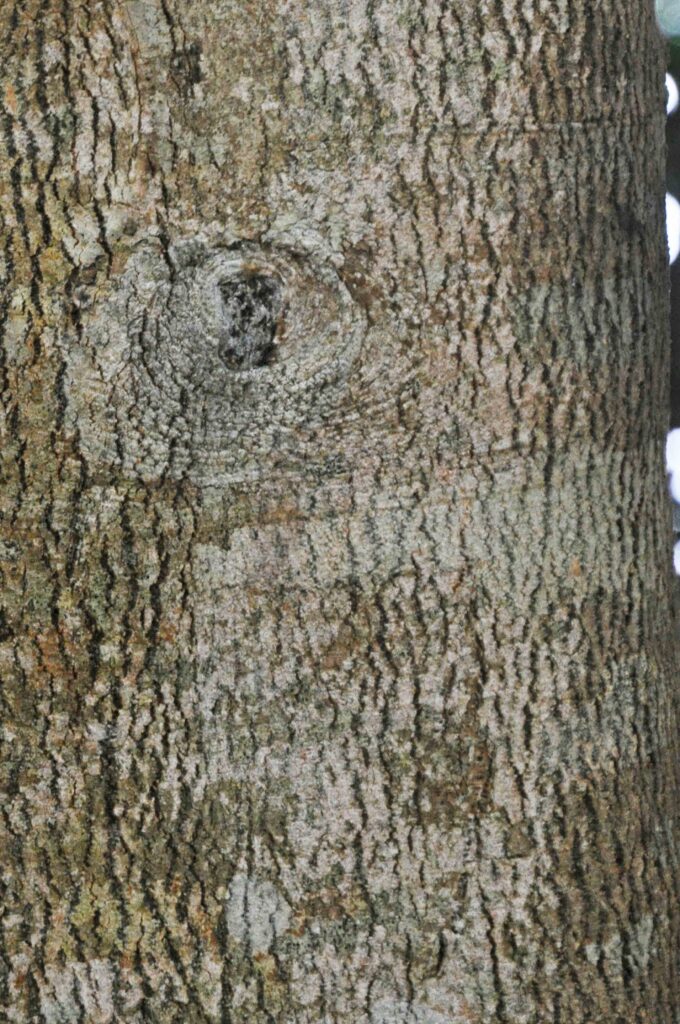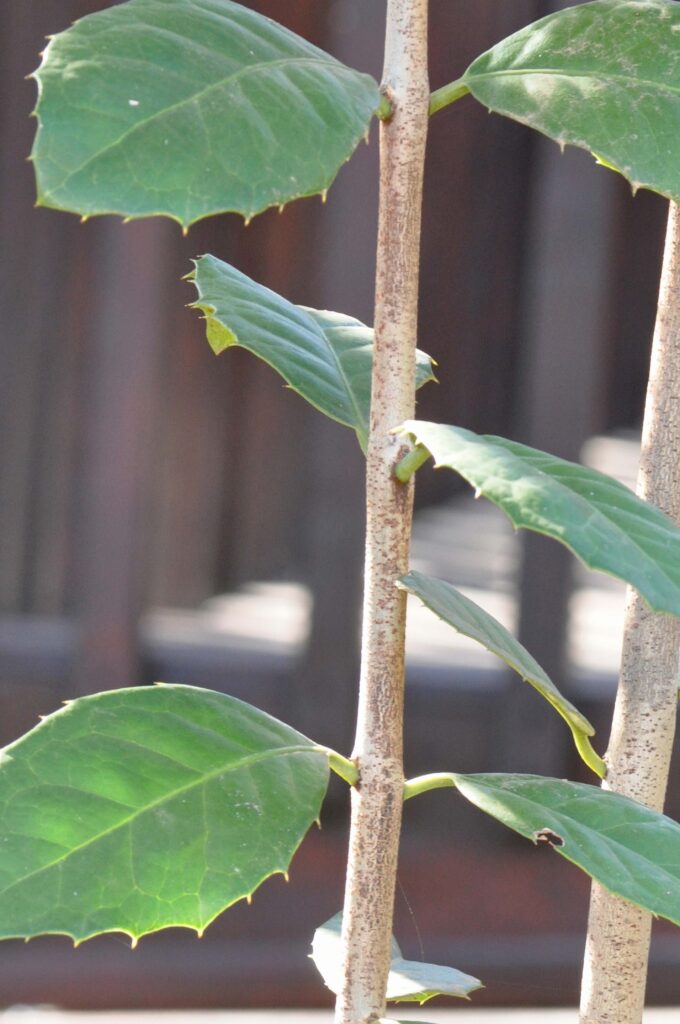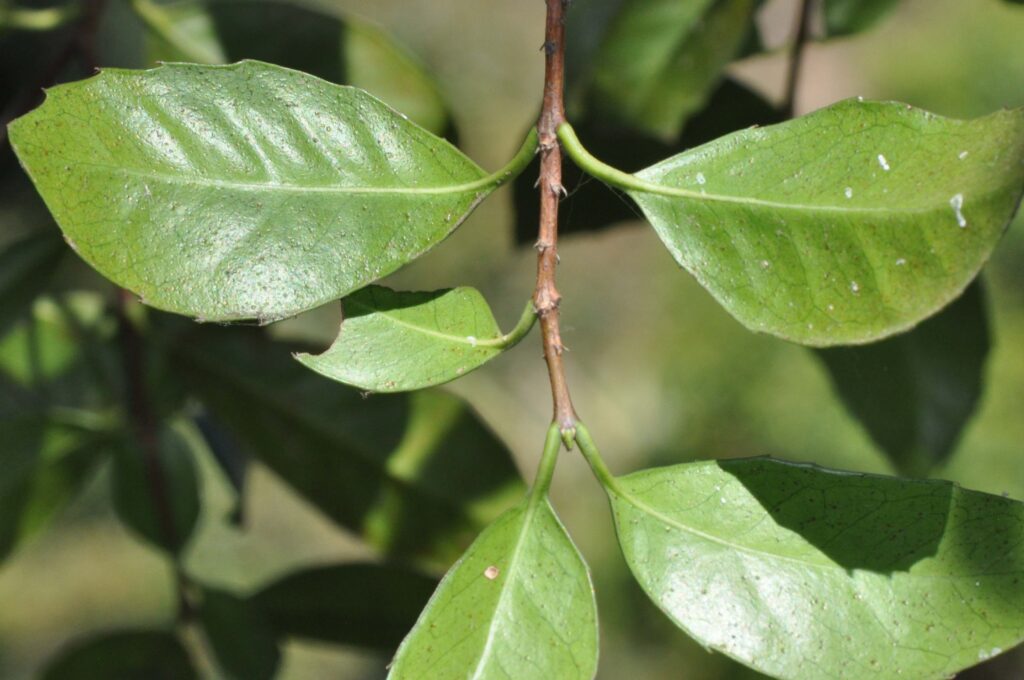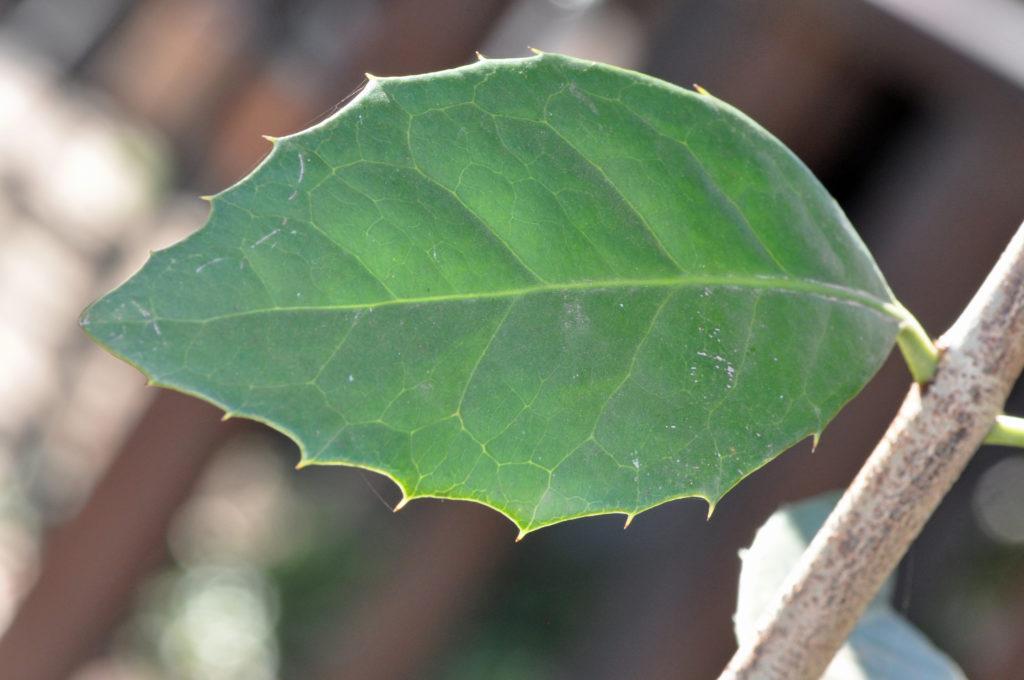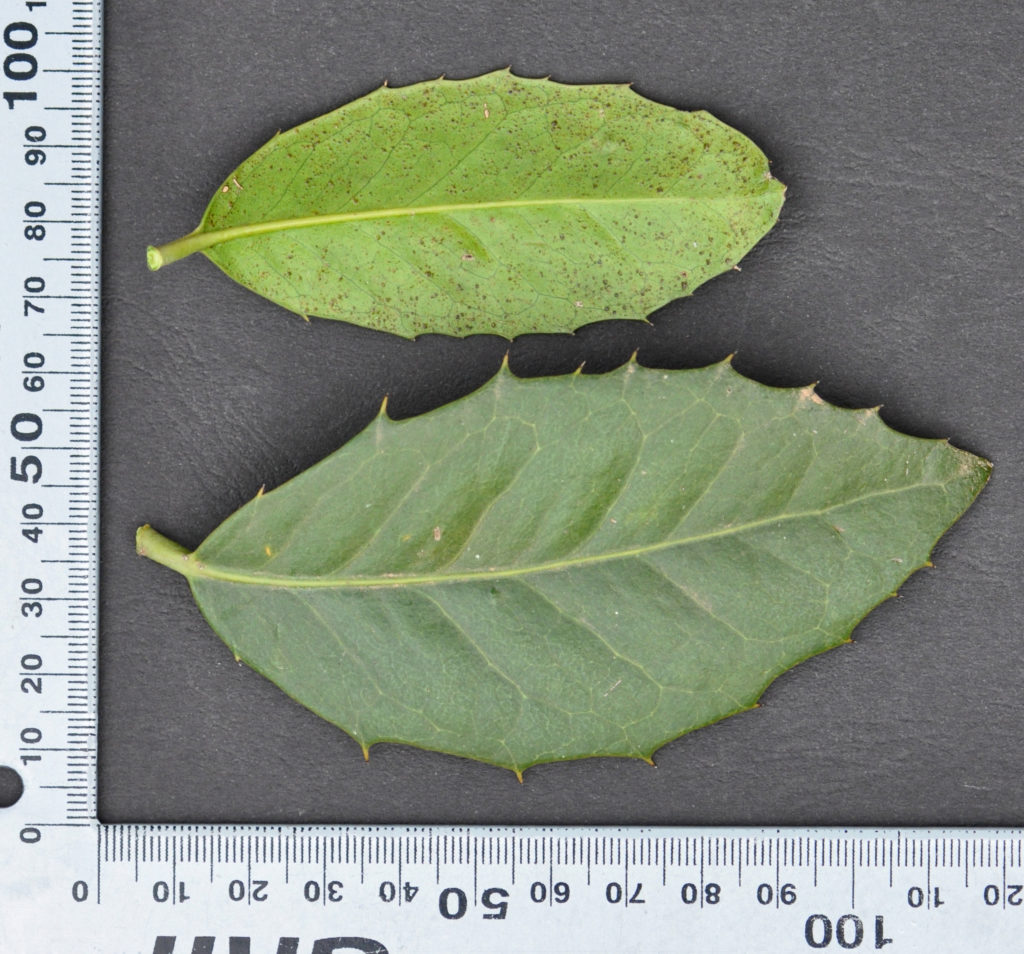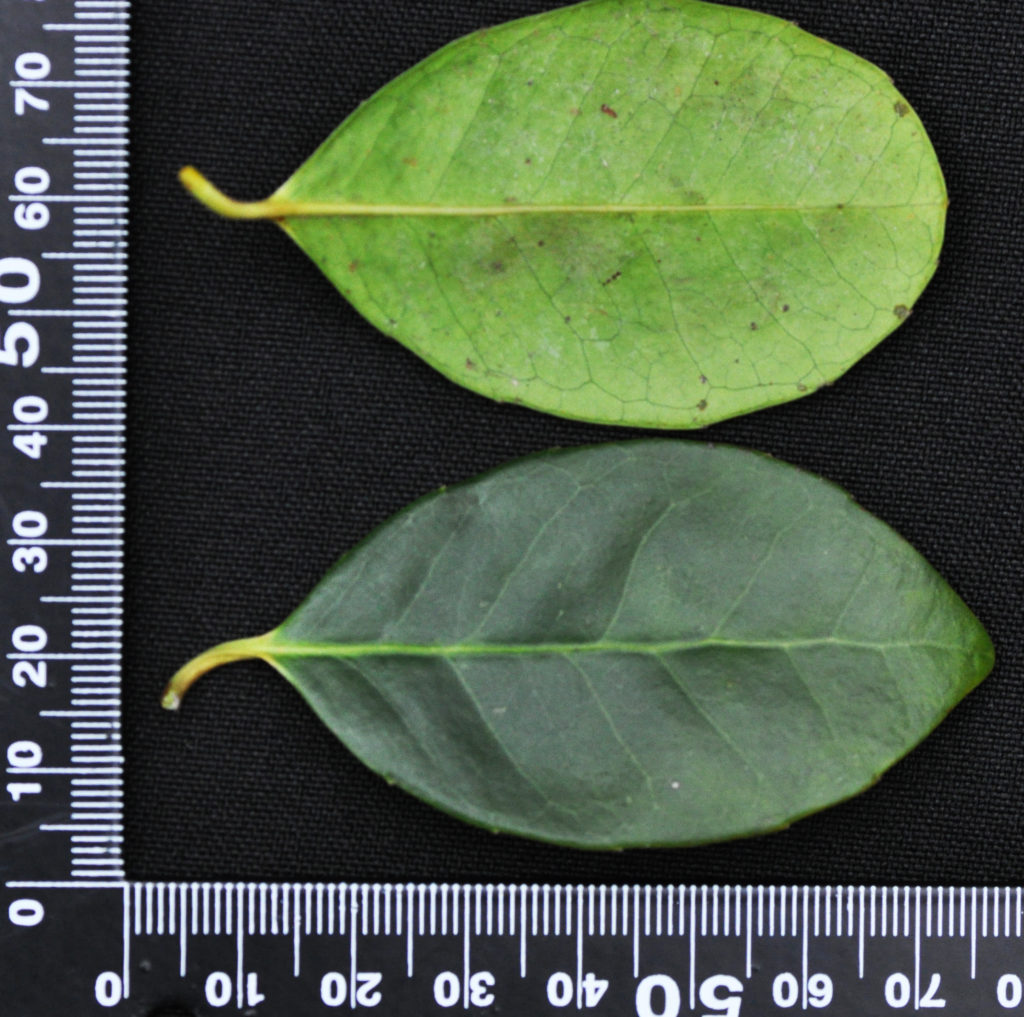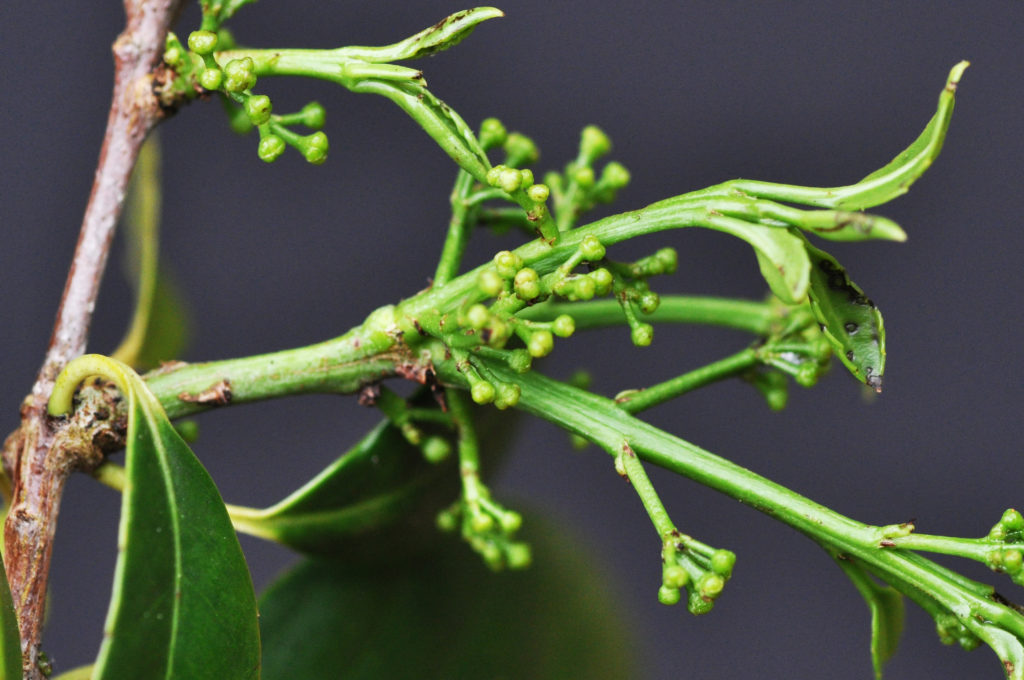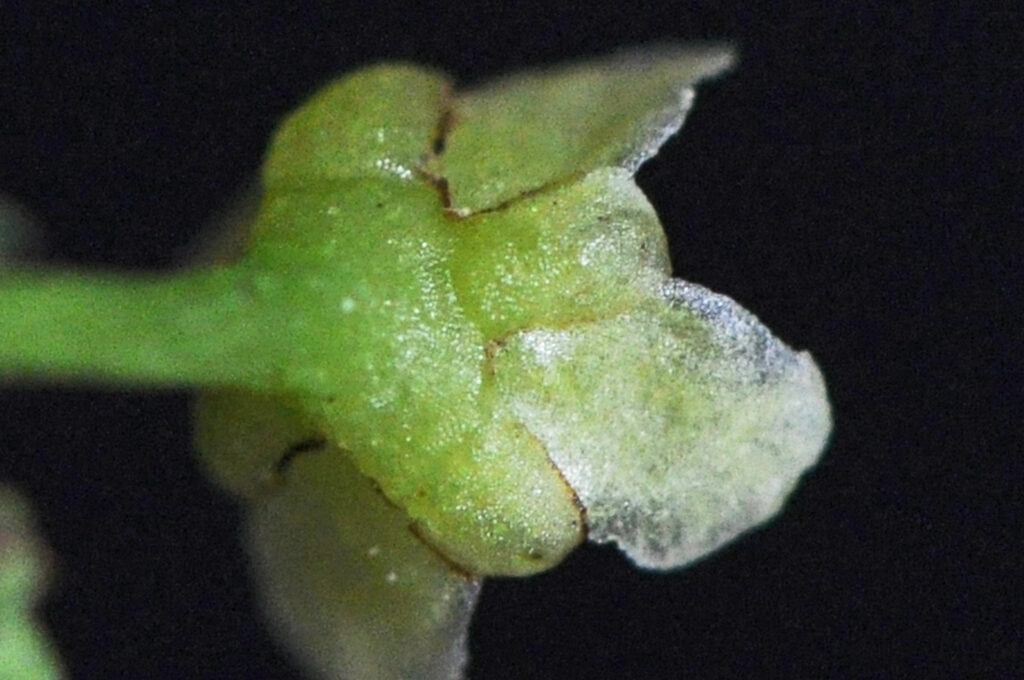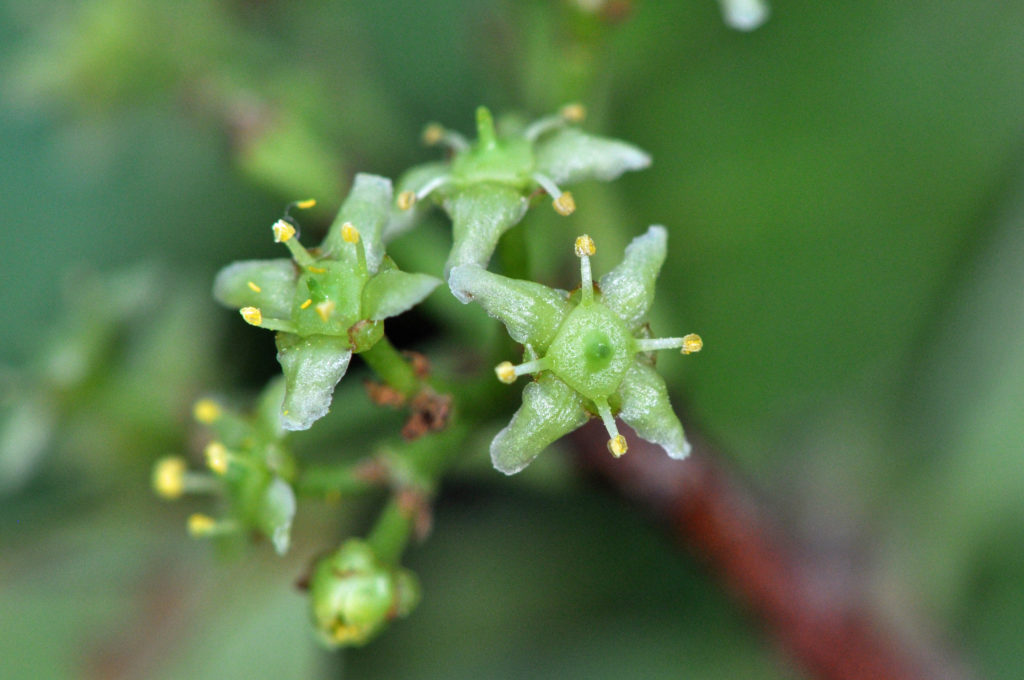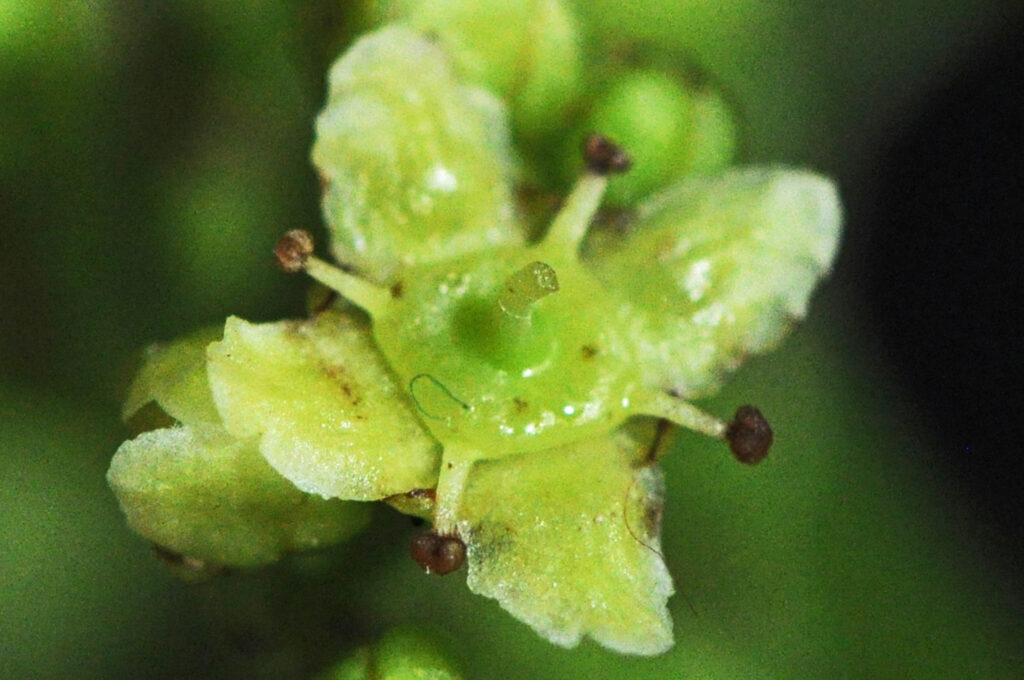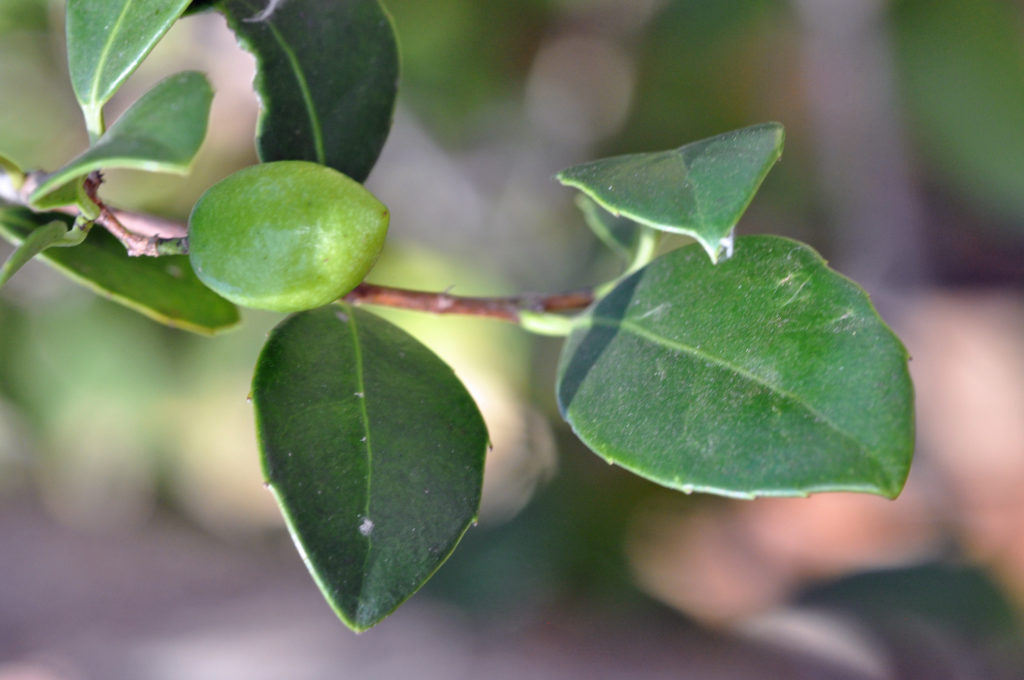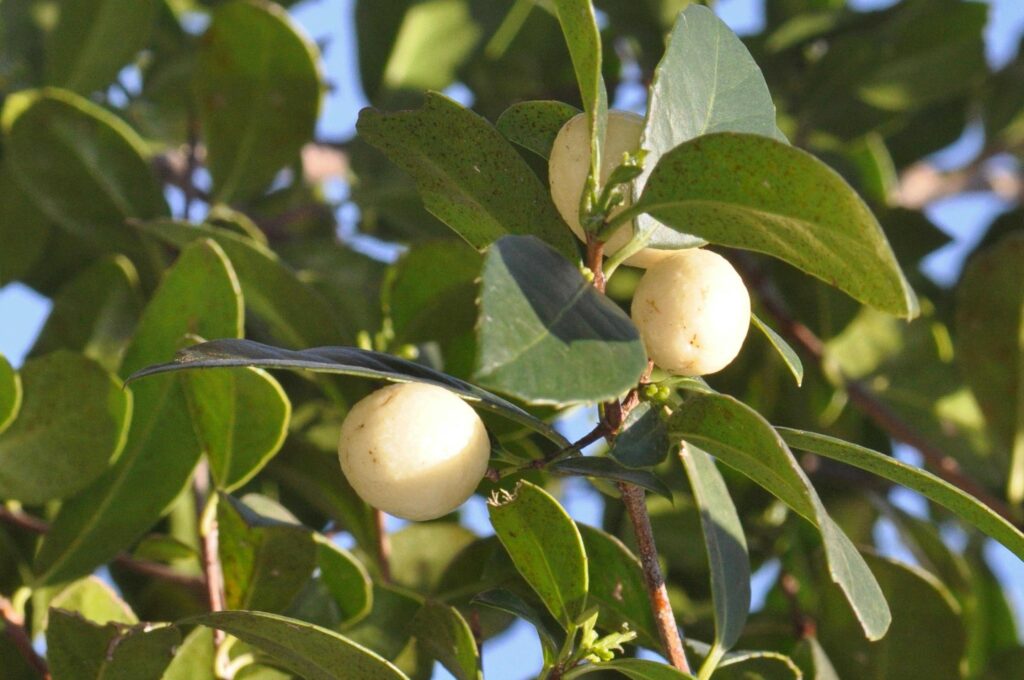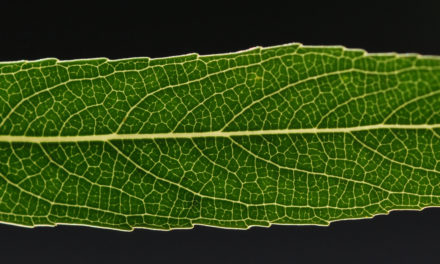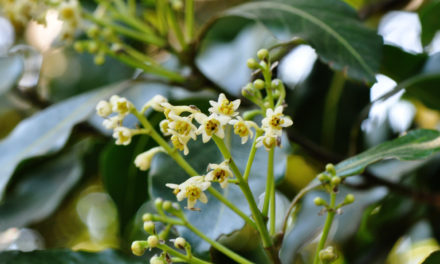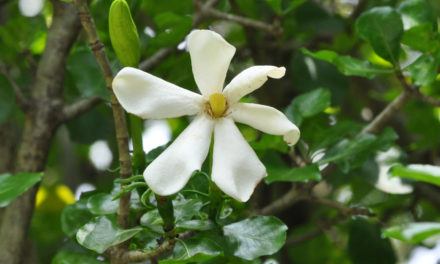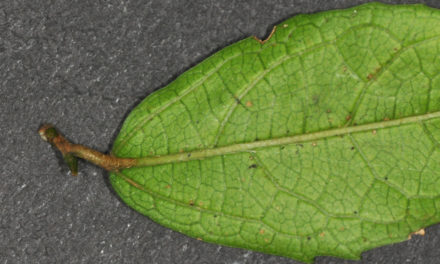General Info – summary
This usually evergreen Tree with thin smooth bark is up to 10m+ high & has a trunk with a diameter to 25cm. Stiff, leathery, simple Leaves may have serrated margins with very small stipules. The bisexual, regular, greenish, 4-merous, Flowers are small – up to 4mm wide & develop in cymes. 4 stamens extend horizontally. The superior ovary has 1 short style. Fruit. The fleshy, ovoid drupe usually has 1 hard seed.
Description
Elaeodendron croceum
Previous Names: Elaeodendron capense, Elaeodendron papillosum, Cassine crocea, Cassine papillosa, Crocoxylon croceum, and Ilex crocea. (Ilex crocea was the name given by Carl Peter Thunberg. He first collected the plant in 1794).
SA Tree No. 415.
Common Names: (Afr) Bossaffraan, Geelhout, Geelhoutboom, Gewone Saffraan, Opregtesaffraan, Opregtesaffraanhout, Opregtesaffraanhout, Regtesaffraan, Regtesaffraan. (Eng) Common Saffron, Forest Saffron, Forest Saffronwood, Saffron, Saffron cassine, Saffron Wood, Small-leaved Saffron, Saffron wood, Yellow Wood. (isiXhosa) Umbomvane, Umbovana, Umbovane, Ummakhankatha. (isiZulu) Ikhukhuze, Isithuntu, Isinama, Umaqunda, Umbomvane, Usahlulamanye, Usehlulamanye. (siSwati) inGulutane. (Tshivenda) Tshibvukahalwa.
Family: Celastraceae. (Spike-thorn, Staff-tree and Bitter-sweet family). There are currently close to 100 genera and in excess of 1 300 species. About 8 of these are in South Arica. Four are included on this website: Catha, Elaeodendron, Gymnosporia and Maytenus. This family has simple Leaves. Flowers are usually small, actinomorphic (regular), bisexual or unisexual and sepals and petals are usually persistent. One or 2 Pollen sacs are present on each Anther. Each opens by a longitudinal slit. The Ovary is usually superior and usually has 2-5 locules. The Style is usually thick, and the Stigma has 2-5 lobes. Fruit varies.
Name derivation: Elaeodendron – Greek: similar to Cassine orientalis from Mauritius whose fruits resemble small olives. croceum – saffron-yellow (freshly exposed bark colour). There are 4 species of the genus Elaeodendron in southern Africa.
Conservation: National Status: L C. Least Concern but Declining. Assessed: 2016 (C.J. Geldenhuys and L. von Staden). This is possibly due to bark harvesting for traditional use – especially in the Eastern Cape and KwaZulu-Natal. The population is decreasing.
Tree
This often much branched shrub or Tree is usually up to 4-5m but may reach 15m high. The usually straight Trunk may be crooked and has a diameter of up to 25cm – usually less. The tree is unarmed and glabrous (hairless). Usually present are prominent dark or black Lenticels (usually raised corky oval or elongated areas on the plant that allow the uncontrolled interchange of gases with the environment – photos 602 & 136). The very thin, smooth Bark is grey to whitish with orange and yellow pigment in the underbark showing through in patches (photo 937). This becomes more visible when the bark the scratched or the tree grows in a damp environment (here the bark peels off naturally). Uncovered roots are also yellow. Two other genera in the family Celastraceae have yellowish bark. They are the Cape saffron Cassine peragua and the white cherry-wood Pterocelastrus echinatus.
- 936. 2018/09/15 Kirstenbosch NBG. Photo: David Becking.
- 602. 2017/10/24 Walter Sisulu NBG. Photo: David Becking.
- 937. 2018/09/15 Kirstenbosch NBG. Photo: David Becking.
- 136M. 2017/10/24 Walter Sisulu NBG. Photo: David Becking.
Leaves
This usually evergreen Tree has distinctive holly-like, opposite to sub-opposite Leaves lack translucent glands and are thick, stiff, hard, leathery and simple (have a single blade, which may have incisions that are not deep enough to divide the leaf into leaflets). They are oblong to broadly elliptic and each leaf is usually up to 7,5 x 4,5cm. However, on young seedlings growing in shady places, leaves may reach 13cm long. The leaves are decussate (arranged in pairs each at right angles to the next pair above or below i.e. rotated 90 degrees along the stem when viewed from above – photo 136 – under Tree). These leaves are dark green above and usually paler below. The Midrib (the main rib of a leaf or leaf-like part, a continuation of the petiole – leaf stalk) is greenish yellow. The Veins are sunken above. The Apex is notched, bluntly to sharply pointed or tapering to broadly so. The Base is broadly tapering. The rolled under Margin is tough, wavy and may be distinctly toothed (photo 804). Serrated young leaves have sharp tipped, widely spaced teeth facing the apex (photo 135). Mature trees have leaves with fewer serrations (photo 932). The Petiole (leaf stalk) is up to 1,5cm long. Stipules (basal appendage of the petiole) are very small and wither but do not fall.
- 193. 2014/06/03 Walter Sisulu NBG. Photo: David Becking.
- 135M. 2014/08/26 Walter Sisulu NBG. Photo: David Becking.
- 804. 2015/08/11 Walter Sisulu NBG. Photo: David Becking.
- 932 2018/09/15 Kirstenbosch NBG. Photo: David Becking.
Flowers
The whitish to greenish or yellow, 4-merous Flowers are small – up to 7mm wide (photo 588). They are borne in clusters at the base of the current years shoots. Occasionally they occur in the axils of lower leaves. Flowers are bisexual and actinomorphic (Regular, symmetrical. They are vertically divisible into similar halves by more than 1 plane passing through the axis). Flowers are in Cymes (determinate flower groups with the central flower opening first) and situated at the ends of young branches on new growth (photo 927). Pedicels (stalks of single flowers) are present and may reach 1,2cm long (photo 927). The Calyx with its 4 green Sepals, has a cone shaped base (photo 25). The Corolla has 4 cream to greenish Petals (photo 23). The 4 Stamens are initially almost vertical but curl backwards as they age.alternate with the petals and spread horizontally (photo 588). There is a single Pistil (a unit of the Gynoecium, the female element of the flower, composed of the Ovary, Style and Stigma). The superior ovary initially has 2 ovules per locule but usually only 1 develops. There is a single short Style and a small Stigma (photos 588 & 23). In photo 23, the darker, ageing Anthers are visible. (Sep-Dec).
- 927. 2018/09/15 Kirstenbosch NBG. Photo David Becking.
- 25. 2018/09/15 Kirstenbosch NBG. Photo David Becking.
- 588. 2017/10/24 Walter Sisulu NBG. Photo: David Becking.
- 23. 2018/09/15 Kirstenbosch NBG. Photo David Becking. Kirstenbosch
Fruit
The fleshy ovoid Fruit is an up to 3cm x 1,5cm wide Drupe (a fleshy, 1-seeded indehiscent fruit with the seed enclosed in a stony endocarp – innermost layer surrounding the seed). It is initially green (photo 195) becoming pale yellow and reaching maturity with following year’s flowers (photo 138). The mature, often wrinkled fruit may have encrustations. Each fruit contains a single brownish Stone (hard seed, like that of a peach or olive). The hard Seeds are brownish and usually mature with the following year’s flowers. An endosperm (the starch and oil-containing tissue of many seeds; often referred to as the albumen) is present and the embryo has 2 fleshy cotyledons (seed leaf; primary leaves in the embryo).
- 195. 2014/06/03 Walter Sisulu NBG. Photo: David Becking.
- 138. 2014/08/26 Walter Sisulu NBG. Photo: David Becking.
Distribution & Ecology
These plants occur along south and eastern South Africa at the edges of coastal and moist inland (often-evergreen) forests, forest margins, as well as dry forests and dune forests. They occur in the Western Cape e.g., George and Knysna, Eastern Cape, KwaZulu-Natal (e.g., Umtamvuna Nature Reserve in southern KwaZulu-Natal is a botanical paradise consisting of an interesting stretch of riverine forest and steep rocky cliffs where this plant can be found), Mpumalanga, Limpopo and the Drakensberg Escarpment. Trees also occur in the eastern highlands of Zimbabwe, west-central Mozambique and in Swaziland. Beyond Africa, they occur in southern USA, Northern South America, India and southeastwards to include Australia. Fruit bats, Rameron pigeons (Columba arquatrix), wild pigs and elephants consume the fruit and help disperse the Seeds.
Ethnobotany
Wood is tough, hard, durable, fine grained and takes a fine polish. The Sapwood is white and heartwood pinkish-purple to brown or even yellowish. Wood usage includes furniture making, carving and engraving. The bitter Bark (used in local medicine) and Leaves have a small amount of tannin that has been used for tanning and dyeing. The plant can be grown from Seed or Cuttings. Some success has been shown from the isolation of an anti-HIV compound from Elaeodendron croceum. The roots, bark and leaves are poisonous and are used in local medicine. Bark extracts have purgative properties.
References
Boon, R. 2010. Pooley’s Trees of eastern South Africa. Flora and Fauna Publications Trust, Durban.
Geldenhuys, C.J. & von Staden, L. 2016. Elaeodendron croceum (Thunb.) DC. National Assessment: Red List of South African Plants version 2020.1. Accessed on 2021/07/12.
Coates Palgrave, M. 2002. Keith Coates Palgrave Trees of Southern Africa. edn 3. Struik, Cape Town.
Geldenhuys, C.J. & von Staden, L. 2016. Elaeodendron croceum (Thunb.) DC. National Assessment: Red List of South African Plants version 2020.1. Accessed on 2023/03/30.
Ginn P, McIlleron W. Milstein P. 1991. The Complete Book of Southern African Birds. Struik, Cape Town.
Palmer, E. & Pitman, N. 1972. Trees of southern Africa. Balkema, Amsterdam
Geldenhuys, C.J. & von Staden, L. 2016. Elaeodendron croceum (Thunb.) DC. National Assessment: Red List of South African Plants version 2020.1. Accessed on 2023/03/30.
van Wyk, B. & van Wyk, P. 1997 Field guide to Trees of Southern Africa. Struik, Cape Town.
http://www.plantzafrica.com/plantefg/elaedendcroc.htm
http://repository.up.ac.za/bitstream/handle/2263/25336/Complete.pdf?sequence=10
http://www.medscape.com/medline/abstract/20234972
http://www.up.ac.za/plant-science/article/44783/prof-marion-jjm-meyer
http://posa.sanbi.org/flora/browse.php?src=SP

